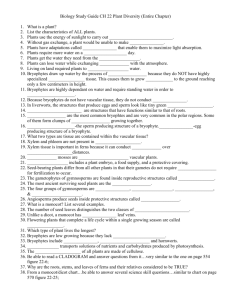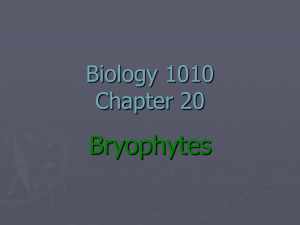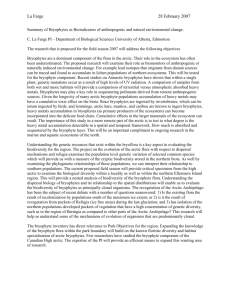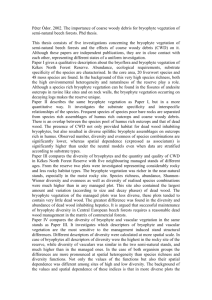Aquatic Bryophytes - Oregon State University
advertisement
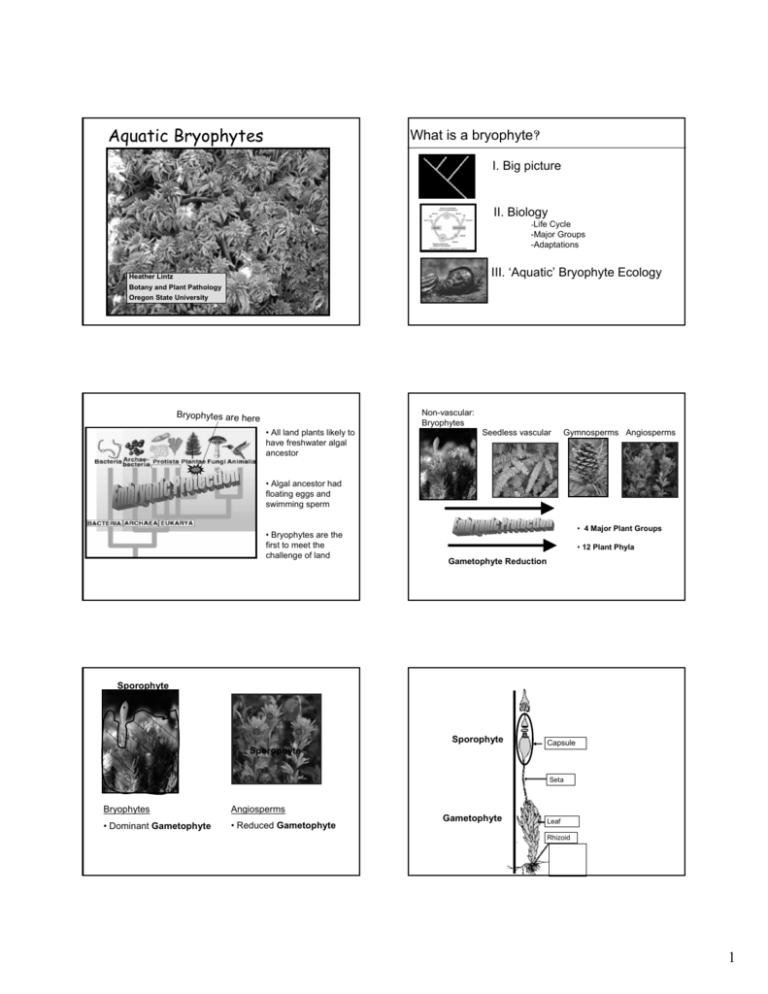
Aquatic Bryophytes What is a bryophyte? bryophyte? I. Big picture II. Biology -Life Cycle -Major Groups -Adaptations III. ‘Aquatic’ Aquatic’ Bryophyte Ecology Heather Lintz Botany and Plant Pathology Oregon State University Non-vascular: Bryophytes Bryophytes are here • All land plants likely to have freshwater algal ancestor Seedless vascular Gymnosperms Angiosperms • Algal ancestor had floating eggs and swimming sperm • Bryophytes are the first to meet the challenge of land • 4 Major Plant Groups • 12 Plant Phyla Gametophyte Reduction Sporophyte Sporophyte Capsule Sporophyte Seta Bryophytes Angiosperms • Dominant Gametophyte • Reduced Gametophyte Gametophyte Leaf Rhizoid 1 Moss Life Cycle Diversity in Bryo Sexuality 2n n 2n n Some species produce millions of spores Sporophyte meiosis fertilization Some species practice abstention Gametophyte Some species are transexual Spores Protonema Antheridia Archegonia What is a bryophyte? bryophyte? 3 Bryophyte Phyla: Bryophyta (Mosses) I. Big picture Hepatophyta (Liverworts) Anthocerophyta (Hornworts) II. Biology Life Cycle differences Major Groups Adaptations similarities thallus III. ‘Aquatic’ Aquatic’ Bryophyte Ecology (tends to be curly) spiral leaf arrangement Distinguishing Features of Phyla Mosses Liverworts Hornworts dorsal-ventral leaf arrangement or thallus What do all bryophytes share? • • Gametophyte dominance Unbranched sporophyte (although, it could be upside-down) To Be Experienced In lab In thalloid livers, umbrella = gametophyte Thalloid liverwort sporophyte 2 What else do all bryophytes share? • Biflagellate sperm • Form of sex organs I. Big picture II. Biology -Life Cycle -Major Groups General -Adaptations! Aquatic Bryos III. ‘Aquatic’ Aquatic’ Bryophyte Ecology antheridium -Aquatic bryo habitats -Moss in bogs archegonium Bryophyte adaptations: A. Obstacle - Dessication Bryophyte adaptations: B. Obstacle - Acquisition minerals Unistratose - Small size - Direct absorption through cells i. Plant : - poikilohydry - growth form - Primitive vasculature: endo vs. ectohydric -size -specialized traits - Cation exchange capacity leptoids -asexual repro: fragmentation; gemmae ii. Spores : -waterproof sporopollenin -spores are world travelers hydroids iii. Gametes : -some protection, but sperm still need film of water Bryophyte adaptations Aquatic Bryophyte Adaptations C. Obstacle - gravity Bryos fight gravity - for light acquisition; spore and gamete dispersal -Primary cell walls only, some turgor support, not much • Generalizations are hard to make • Submerged aquatic bryos have: low surface texture, open growth from • Some aquatic bryos are considered ‘xeric hydrophytes’ 3 Some example questions in bryophyte ecology: Bryophyte Ecology The science of relationships between organisms and their environment How do bryophyte communities vary with environmental factors? How (and why) do species co-exist? Where are aquatic bryophytes found? Oikos- home Oekologie Ecology Ernst Häeckel 1834-1919 ‘The study of home’ e xt What can bryophytes tell us aboutd Deli n 4 rl Wo day at global climate change? s Old Tue How do bryophytes regulate the environment? Where are ‘aquatic’ bryophytes commonly found? Riparian and aquatic habitats in wadeable freshwater channels = Bryophyte Heaven Bryophytes are generally not abundant in marshes Lakes and Ponds = bryos can be found along shorelines or in submerged habitats MARSHES: Wetlands dominated by emergent plants FENS: groundwater-driven peatlands Bryos can abound!!! Bryos are not in the ocean FENS contain ‘brown mosses,’ A functional group of moss genera known as ‘fen indicators’: Brachythecium Amblystegium Aulacomnium 4 BOGS: Precipitation-driven peatlands dominated by Sphagnum Next eco question: How do bryophytes regulate the environment (for example, in bogs)? Sphagnum traits that influence the bog environment: • water holding capacity • indeterminate growth • cation exchange capacity Sphagnum Landscape characteristics Climate The End Bog characteristics: • stagnant water (not flowing) • anaerobic environment • cations and nutrients are scarce • very acidic • no bacterial decomposition = mummification 5

